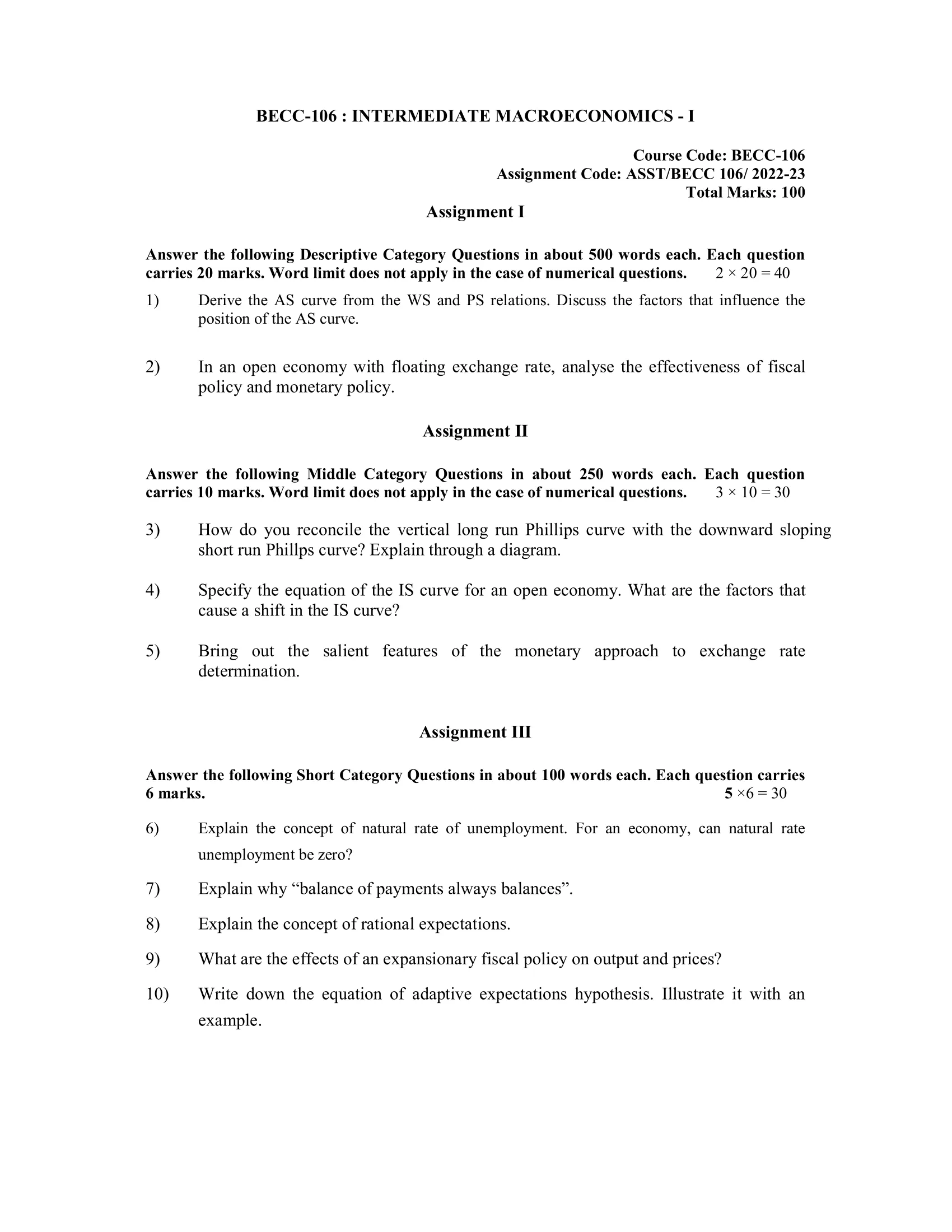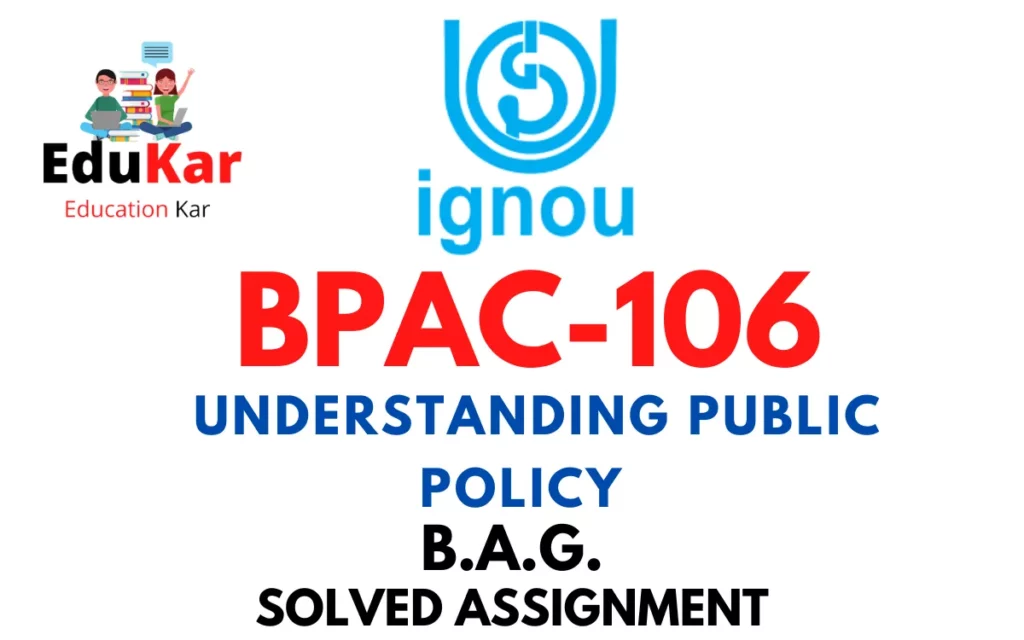Contents
- 1 Assignment I
- 2 Answer the following Descriptive Category Questions in about 500 words each. Each question carries 20 marks. Word limit does not apply in the case of numerical questions.
- 3 1) Derive the AS curve from the WS and PS relations. Discuss the factors that influence the position of the AS curve.
- 4 2) In an open economy with floating exchange rate, analyse the effectiveness of fiscalpolicy and monetary policy.
- 5 Assignment II
- 6 Answer the following Middle Category Questions in about 250 words each. Each question carries 10 marks. Word limit does not apply in the case of numerical questions.
- 7 3) How do you reconcile the vertical long run Phillips curve with the downward slopingshort run Phillps curve? Explain through a diagram.
- 8 4) Specify the equation of the IS curve for an open economy. What are the factors thatcause a shift in the IS curve?
- 9 5) Bring out the salient features of the monetary approach to exchange ratedetermination.
- 10 Assignment III
- 11 Answer the following Short Category Questions in about 100 words each. Each question carries 6 marks.
- 12 6) Explain the concept of natural rate of unemployment. For an economy, can natural rate unemployment be zero?
- 13 7) Explain why “balance of payments always balances”.
- 14 8) Explain the concept of rational expectations.
- 15 9) What are the effects of an expansionary fiscal policy on output and prices?
- 16 10) Write down the equation of adaptive expectations hypothesis. Illustrate it with an example.

| Title | BECC-106: IGNOU BAG Solved Assignment 2022-2023 |
| University | IGNOU |
| Degree | Bachelor Degree Programme |
| Course Code | BECC-106 |
| Course Name | INTERMEDIATE MACROECONOMICS-I |
| Programme Name | Bachelor of Arts (General) |
| Programme Code | BAG |
| Total Marks | 100 |
| Year | 2022-2023 |
| Language | English |
| Assignment Code | ASST/BECC 106/ 2022-23 |
| Last Date for Submission of Assignment: | For June Examination: 31st April For December Examination: 30th September |

Assignment I
Answer the following Descriptive Category Questions in about 500 words each. Each question carries 20 marks. Word limit does not apply in the case of numerical questions.
1) Derive the AS curve from the WS and PS relations. Discuss the factors that influence the position of the AS curve.
Ans: In an open economy with a floating exchange rate, the effectiveness of fiscal policy and monetary policy can greatly impact the economy’s performance. Both policies have the ability to influence economic activity, but they do so in different ways.
Fiscal policy refers to the government’s use of spending and taxation to influence the economy. An expansionary fiscal policy, which involves an increase in government spending or a decrease in taxes, can lead to an increase in aggregate demand, thereby boosting economic growth. Conversely, a contractionary fiscal policy, which involves a decrease in government spending or an increase in taxes, can reduce aggregate demand and slow down the economy.
However, the effectiveness of fiscal policy in an open economy with a floating exchange rate is limited by a number of factors. For example, if a country’s government increases its spending, it may lead to an increase in its budget deficit, which can lead to an increase in government borrowing and a rise in interest rates. This in turn can lead to an appreciation of the exchange rate, which can hurt the competitiveness of the country’s exports, reduce demand for imports, and ultimately harm the economy.
Monetary policy, on the other hand, refers to the actions of the central bank in controlling the money supply and interest rates to influence the economy. A monetary expansion, which involves an increase in the money supply or a decrease in interest rates, can boost aggregate demand and economic growth. Conversely, a monetary contraction, which involves a decrease in the money supply or an increase in interest rates, can reduce aggregate demand and slow down the economy.
In an open economy with a floating exchange rate, monetary policy can be more effective in influencing economic activity compared to fiscal policy. The central bank can control the money supply and interest rates to affect the exchange rate, which in turn can impact economic activity. For example, if the central bank lowers interest rates, it can cause the exchange rate to depreciate, making exports cheaper and more competitive. This can increase demand for exports and boost the economy.
2) In an open economy with floating exchange rate, analyse the effectiveness of fiscal
policy and monetary policy.
Ans: The Aggregate Supply (AS) curve is a graphical representation of the relationship between the price level and the quantity of output that firms are willing and able to produce in an economy. The AS curve can be derived from the supply side of the economy, specifically from the relationships between the Wage-Price (WS) spiral and the Profit-Price (PS) spiral.
The WS spiral refers to the feedback loop between wages and prices. When firms raise their prices, workers may demand higher wages to compensate for the higher cost of living. This, in turn, may cause firms to raise their prices further to cover the higher wage costs. This feedback loop can lead to inflation. On the AS curve, this relationship is represented as a positive slope, as higher wages and prices lead to a higher level of output.
The PS spiral refers to the relationship between profits and prices. When firms raise their prices, their profits increase. This, in turn, can lead to increased investment, which can boost productivity and lead to higher output. On the AS curve, this relationship is represented as a positive slope, as higher profits and prices lead to a higher level of output.
The position of the AS curve can be influenced by a number of factors, including the availability of labor, capital, and other resources, technological progress, and the overall level of economic activity. For example, if there is an increase in the availability of resources, the AS curve will shift to the right, indicating an increase in output at each price level. Similarly, if there is an improvement in technology, the AS curve will shift to the right, reflecting increased productivity and a higher level of output.
In addition, changes in macroeconomic conditions can also affect the position of the AS curve. For example, if there is an increase in the demand for goods and services, the AS curve may shift to the right, reflecting the ability of firms to produce more output at each price level. Conversely, if there is a decrease in demand, the AS curve may shift to the left, indicating a decrease in output at each price level.
Assignment II
Answer the following Middle Category Questions in about 250 words each. Each question carries 10 marks. Word limit does not apply in the case of numerical questions.
3) How do you reconcile the vertical long run Phillips curve with the downward sloping
short run Phillps curve? Explain through a diagram.
Ans: The Phillips curve is a graphical representation of the inverse relationship between inflation and unemployment in an economy. The short-run Phillips curve slopes downwards, reflecting the trade-off between inflation and unemployment in the short run. This trade-off is based on the expectation that firms will raise prices in response to an increase in aggregate demand, leading to lower unemployment in the short run.
On the other hand, the vertical long-run Phillips curve suggests that there is no trade-off between inflation and unemployment in the long run. In other words, any increase in aggregate demand will result in only higher inflation and not lower unemployment in the long run.
To reconcile the vertical long-run Phillips curve with the downward sloping short-run Phillips curve, it is important to understand that the short-run Phillips curve is based on expectations of firms, while the long-run Phillips curve is based on the actual relationship between inflation and unemployment.
In the short run, if aggregate demand increases, firms may expect that this increase in demand is temporary and therefore only raise prices temporarily. This will result in lower unemployment in the short run. However, in the long run, if aggregate demand continues to increase, firms will eventually realize that this increase is not temporary and will raise prices permanently. This will result in higher inflation and not lower unemployment.
To summarize, the reconciliation of the vertical long-run Phillips curve and the downward sloping short-run Phillips curve can be understood through the following diagram:
| | | | Short-run Phillips curve | | | | |____________|
| | | | Long-run Phillips curve | | | | |____________|
In this diagram, the short-run Phillips curve slopes downwards to the right, reflecting the short-run trade-off between inflation and unemployment. The long-run Phillips curve is vertical, reflecting the absence of a trade-off between inflation and unemployment in the long run. Over time, as expectations of firms adjust to the actual relationship between inflation and unemployment, the short-run Phillips curve will shift upwards to eventually converge with the long-run Phillips curve.
4) Specify the equation of the IS curve for an open economy. What are the factors that
cause a shift in the IS curve?
Ans: The IS curve is a graphical representation of the relationship between interest rates and real GDP in an economy, with the IS standing for “investment-saving”. The IS curve is used to analyze the impact of changes in interest rates on aggregate demand and output in an open economy.
The equation for the IS curve in an open economy is:
Y = C(Y – T) + I(r) + G + NX
Where: Y is real GDP C is consumption, which is a function of disposable income (Y – T) I(r) is investment, which is a function of the interest rate G is government spending NX is net exports, which is the difference between exports and imports
The IS curve shifts in response to changes in the underlying factors that affect aggregate demand, including changes in government spending, autonomous consumption and investment, net exports, and expectations. Some of the factors that cause a shift in the IS curve are:
- Changes in government spending: An increase in government spending leads to an increase in aggregate demand, shifting the IS curve to the right.
- Changes in autonomous consumption and investment: An increase in autonomous consumption and investment leads to an increase in aggregate demand, shifting the IS curve to the right.
- Changes in net exports: An increase in net exports (exports minus imports) leads to an increase in aggregate demand, shifting the IS curve to the right.
- Changes in expectations: Changes in expectations about future income, interest rates, and inflation can affect aggregate demand and shift the IS curve.
5) Bring out the salient features of the monetary approach to exchange rate
determination.
Ans: The monetary approach to exchange rate determination is a theory that focuses on the role of money in determining the exchange rate between two currencies. This approach holds that changes in the money supply and changes in the demand for money are the main determinants of changes in exchange rates.
One of the key features of the monetary approach is the emphasis on the role of money as a commodity. According to this theory, the demand for money is a function of the nominal income of an economy and the expected inflation rate. An increase in the money supply leads to an increase in the nominal income and, in turn, to a higher demand for the currency. This, in turn, leads to an appreciation of the currency and a rise in the exchange rate.
Another important feature of the monetary approach is the role of expectations. This theory holds that expectations play a crucial role in determining exchange rates. For example, if investors expect a rise in inflation in a particular country, they may start to demand more of the currency of that country, leading to an appreciation of the currency and a rise in the exchange rate.
The monetary approach also recognizes that changes in the interest rate can impact the exchange rate. An increase in the interest rate in one country relative to another can lead to an increase in the demand for the currency of the country with the higher interest rate, leading to an appreciation of the currency and a rise in the exchange rate.
Assignment III
Answer the following Short Category Questions in about 100 words each. Each question carries 6 marks.
6) Explain the concept of natural rate of unemployment. For an economy, can natural rate unemployment be zero?
Ans: The natural rate of unemployment, also known as the non-accelerating inflation rate of unemployment (NAIRU), is the level of unemployment at which inflation remains stable over the long-term. This means that if the actual unemployment rate is higher than the natural rate, inflation is likely to decline, and if the actual unemployment rate is lower than the natural rate, inflation is likely to rise.
It is important to note that the natural rate of unemployment represents a theoretical concept, and it can be difficult to estimate its exact level. However, it is generally believed to include a certain amount of frictional and structural unemployment, which are types of unemployment that are inherent in an economy.
In theory, the natural rate of unemployment cannot be zero, as there will always be some level of frictional and structural unemployment in an economy. Frictional unemployment arises from workers transitioning between jobs, while structural unemployment arises from changes in the economy, such as technological advancements, that render certain skills and industries obsolete.
Therefore, the goal of monetary and fiscal policy should not be to achieve zero unemployment, as this is not possible, but to keep the actual unemployment rate close to its natural rate, so as to maintain price stability and promote economic growth.
7) Explain why “balance of payments always balances”.
Ans: The balance of payments (BOP) is a record of all economic transactions between residents of one country and residents of all other countries over a specific period of time, usually a year. The BOP is divided into two main components: the current account and the capital account. The current account measures trade in goods and services, while the capital account measures flows of investment and financing.
The balance of payments always balances because every transaction has both a credit and a debit side. For example, when a country imports goods from abroad, it incurs a debit in the current account, but it also earns a credit in the capital account through the payment for those goods. Similarly, when a country exports goods, it incurs a credit in the current account, but it also incurs a debit in the capital account for the payment received for those goods.
Therefore, the balance of payments always balances because every transaction is recorded as both a credit and a debit. This means that the sum of credits in the current and capital accounts must equal the sum of debits in the current and capital accounts. If a country has a surplus in its current account, it must have a deficit in its capital account, and vice versa.
8) Explain the concept of rational expectations.
Ans: Rational expectations is a theoretical concept in economics that refers to the idea that individuals make decisions based on their best prediction of the future. According to this theory, individuals are rational and have the ability to learn from past experiences, and they use this information to make predictions about the future. These predictions are based on the individual’s expectation of how the economy will perform, including the behavior of other individuals and the behavior of the government.
Under rational expectations, individuals make decisions that are consistent with their expectations. For example, if individuals expect inflation to rise, they will adjust their behavior accordingly, such as by demanding higher wages or investing in inflation-protected assets. This means that their behavior can influence the actual outcome, making it more likely that their expectations will be realized.
The concept of rational expectations has important implications for economic policy. For example, if the government tries to manipulate the economy by pursuing expansionary monetary or fiscal policy, individuals may anticipate this and adjust their behavior accordingly, making the policy less effective. This is known as the “policy ineffectiveness proposition.”
9) What are the effects of an expansionary fiscal policy on output and prices?
Ans: Expansionary fiscal policy refers to an increase in government spending or a reduction in taxes that stimulates the economy. The effects of this type of policy on output and prices are as follows:
Output: Expansionary fiscal policy can increase aggregate demand, leading to higher output and economic growth. The increased demand for goods and services results in firms producing more, leading to an increase in employment and a decrease in unemployment.
Prices: Expansionary fiscal policy can also lead to higher prices, as the increased demand for goods and services can put upward pressure on prices. This effect is known as inflation. However, the extent to which expansionary fiscal policy leads to inflation depends on the state of the economy. If the economy is operating at or near full employment, the inflationary impact of expansionary fiscal policy will be greater.
It is worth noting that while expansionary fiscal policy can be effective in boosting output and employment in the short run, it can also lead to long-term problems such as higher government debt and inflation expectations. Thus, policymakers must weigh the short-term benefits of expansionary fiscal policy against its long-term costs when making decisions about fiscal policy.
10) Write down the equation of adaptive expectations hypothesis. Illustrate it with an example.
Ans: The equation of the adaptive expectations hypothesis is as follows: E(yt+1) = Et(yt), where “E” represents the expectation, “yt+1” represents the expected value of the variable “y” in the next period, and “yt” represents the expected value of the variable “y” in the current period.
In simpler terms, the adaptive expectations hypothesis states that individuals base their expectations of future events on past experiences, and they adjust these expectations as they gain new information.
For example, consider an individual who is considering purchasing a certain stock. If the stock has performed well in the past, the individual may have high expectations for its future performance. However, if new information becomes available indicating that the company is experiencing financial difficulties, the individual may revise their expectations downward. This adjustment of expectations based on new information is an example of the adaptive expectations hypothesis in action.
How to Download BECC-106 Solved Assignment?
You can download it from the www.edukar.in, they have a big database for all the IGNOU solved assignments.
Is the BECC-106 Solved Assignment Free?
Yes this is absolutely free to download the solved assignment from www.edukar.in
What is the last submission date for BECC-106 Solved Assignment?
For June Examination: 31st April, For December Examination: 30th October
















